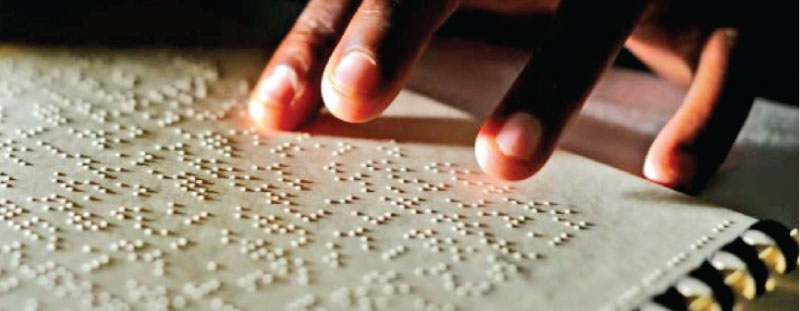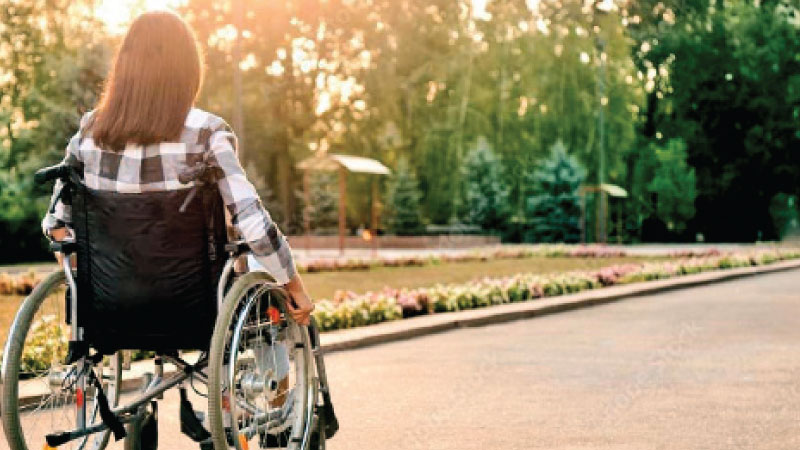What is the image that you conjure up when you hear the term “able-bodied”? It means a person who has, and is in full control of, all bodily organs. But not everyone is so lucky.
 An estimated 1.3 billion people out of the world population of eight billion experience significant disability. This represents 16 percent of the world’s population, or in simple terms, one in six of us.
An estimated 1.3 billion people out of the world population of eight billion experience significant disability. This represents 16 percent of the world’s population, or in simple terms, one in six of us.
Life is indeed difficult for those born with some sort of disability or those who get disabled later in life through accidents, disease and other circumstances. At the same time, many disabled people have unique talents and skills (inborn or acquired) which sometimes exceed those of able-bodied persons. Sometimes, Nature itself lends a hand to those who lack one or more cognitive functions. For example, it is rather well-known that most blind people have exceptional hearing that helps them navigate the world around them with minimal help. Hence the politically correct term “differently-abled” for those who suffer from some sort of disability.
Overall, though, life is difficult for those experiencing some sort of disability. Many persons with disabilities die up to 20 years earlier than those without disabilities. Persons with disabilities have twice the risk of developing conditions such as depression, asthma, diabetes, stroke, obesity or poor oral health. According to the United Nations (UN), health inequities arise from unfair conditions faced by persons with disabilities, including stigma, discrimination, poverty, exclusion from education and employment, and barriers faced in the health system itself. Just to give an example, even some hospitals do not have access ramps for wheelchairs.

Sugath Wasantha de Silva, Sri Lanka’s first ever visually impaired MP
The leadership of persons with disabilities is epitomised by the global disability rights movement’s slogan “Nothing About Us Without Us”. It connotes the basic requirements of participation, representation and inclusion and calls for persons with disabilities to actively shape the conditions of their lives.
Promoting inclusive development
One of the priorities of the global disability agenda is to advance the agency and leadership of persons with disabilities. In the past decades, persons with disabilities and organisations of persons with disabilities (OPDs) have already championed for the changes in their communities, and have been leading many of the community-led initiatives not only to advance their own rights, and wellbeing but also promoting inclusive development for instance enabling universal access to basic services by all; they have done so by taking both targeted and mainstreaming approaches to disability inclusion through, among others, consultation, data collection and analysis, and support with advocacy and accountability efforts.
The observance of the International Day of Persons with Disabilities 2024 (IDPD 2024) on December 3 takes place against the backdrop of pivotal global developments, from the Summit of the Future to the upcoming Second World Summit for Social Development. These key global Summits will complement one another in providing a continuous roadmap toward disability-inclusive and sustainable peace and development. By emphasising this complementarity, the theme chosen for the observance in 2024 aims to underscore the importance of leveraging the leadership of persons with disabilities to ensure disability-inclusive and sustainable peace and development for all.
In this regard, a recent development in Sri Lanka bodes well. For the first time ever in Sri Lanka, a visually impaired person has become a Member of Parliament. This is a significant breakthrough, as he will be a beacon of hope for many other differently-abled persons to reach greater horizons in life. It is hoped that this will open the door to many more disabled persons to tread the same path.
A disability should not be a liability to the person concerned or to the society. In other words, they can be productive and useful to society. One shortcoming we have witnessed in Sri Lanka is that many so-called “equal opportunity” employers are rather reluctant to recruit differently-abled persons. But there are many jobs that they can do with some training. For example, a visually impaired person can easily work as a telephone operator. A hearing impaired person can engage in clerical duties without any difficulty. Yet, only a few companies give them a chance. And it is extremely rare for a differently-abled person to become a company director or CEO here, though in other countries there are plenty of examples.
Another bone of contention is the paucity or even outright lack of support services for the disabled community. Guide dogs for the legally blind are unheard of here, whereas it is very common abroad. Guide dogs are literally the eyes of visually impaired persons and allow them to live independently without having a permanent human guide.
The Government or a charity (foreign funding is readily available) should begin a “training school” for guide dogs (the main breeds are Golden Retrievers, Labradors, Standard Poodles, Border Collies, Australian Shepherds, Boxers, Airedales, Collies and Doberman) in Sri Lanka, so that they can be allocated to visually impaired persons. Granted, maintaining a GR or BC is rather expensive, but again, a charity can step in. More books should be published in Braille and all equipment used by the blind should be allowed in duty and tax free.
Another challenge
The hearing impaired have another challenge – there are only around 10 professionally qualified sign language translators in the whole country. Only two channels employ sign language translators for news broadcasts, though Parliament proceedings are also shown with sign language interpretation. The country needs more real-time sign language interpreters. In the alternative, all TV programs should be subtitled in Sinhala and Tamil, as appropriate. All hearing aids and implants imports should be free of duties and taxes.
Although all new buildings are supposed to be disabled-friendly, this is not always the case as we have observed in many instances. Many of them still do not have ramps for wheelchair access nor toilets designed for wheelchair users. While city planners have designed pebble effect sidewalks and crossings with audible signals for the visually impaired, such facilities have not been extended to most buildings. Even elevators are supposed to have tactile numbers for their benefit, but such lifts are few and far between. Also, there should be more outlets for making and selling prosthetics that benefit amputees, both congenital and accident cases. Again, all equipment for these persons should be free of import duties and taxes.
Society has still not taken cognisance of silent disabilities, whereby a person may appear to be completely normal but is actually harbouring a disability within. Dementia is one such disability, of which even scientists know little about. The condition can, however, be really debilitating, not only for the patient but also for his or her family members. Some people may also be suffering inside from depression or other mental issues, which may take a heavy toll including suicide. It is best to seek counselling in such instances.
Some physical diseases may also manifest as disabilities. Long Covid, a condition where some Covid-19 symptoms such as fatigue and joint pains last for a couple of years, can make a patient effectively bed-ridden. Then there are diseases that can gradually lead to permanent disability – a good example being Glaucoma, which can lead to blindness if not detected and treated early. Osteoporosis can be dangerous in the case of a fall. In fact, many disabilities can be prevented if preventive action and mindfulness are practised.
It is no secret that many accidents happen in workplaces. Occupational Safety must be a priority for all workplaces, but especially so in the case of factories, construction sites and machinery operations. From helmets to boots to goggles, all safety precautions and protective wear regulations must be followed to avoid accidents. Motor accidents can also result in severe disabilities, mostly the loss of limbs. It is best to practice discipline while on the road, regardless of whether you are a motorist or a pedestrian. This can prevent most accidents.
A disability may no longer be a lifetime sentence of suffering if technology has its way. If you remember TV serials such as Six Million Dollar Man and Bionic Woman (well, I am a child of the 80s), they feature lead characters who have bionic or artificial implants that are way more powerful than natural organs such as eyes and hands. The hit movie Robocop featured a “dead” policeman who is brought back to life through such bionic implants. But this may be commonplace say, a decade or two from now.
The biggest breakthroughs are reported from vision advancements targeted at the legally blind. Right now, “bionic” eyes work well only for those who have had sight previously, but solutions are on the way for those blind from birth or infancy. Some scientists have turned to Nature in the hunt for bionic vision. A team of engineers from the Center for Nanoparticle Research, Seoul National University, the Gwangju Institute of Science and Technology and the Korea Institute of Science and Technology, all in Korea, has developed a new type of artificial eye based on natural cat eyes.
Latest research
Meanwhile, results of the first clinical trial of Australia’s second-generation bionic eye have demonstrated ‘substantial improvement’ in four participants’ functional vision, daily activities and quality of life over a period of more than two and a half years. The bionic eye comprises an electrode array, designed by the Bionics Institute and the Center for Eye Research Australia, that is surgically implanted behind the eye. The electrode receives signals from a video camera mounted on glasses, which stimulate the patient’s retina. The camera converts images into electrical pulses delivered by the electrode array that activate retinal cells and create flashes of light called phosphenes to help patients detect edges, shapes and movement.
Likewise, there are high hopes for those who have lost their limbs in accidents or even partially paralysed persons. Scientists have now realized that restoring full mobility for such persons means restoring the ability to sense touch and temperature, not just hold an object. However, many challenges remain because Somatosensation — the collection of senses that interpret touch, temperature, pain and body position — is dauntingly complex. Yet, rapid advances in prosthetics are likely to give a new lease of life for amputees and those who do not possess one or more limbs from birth. In fact, advanced exoskeletons could enable even totally paralysed persons to walk.
The final, and perhaps the most controversial frontier in the battle against is gene editing in the womb itself. In other words, scientists are even now theoretically capable of identifying certain congenital diseases and defects in fetuses and rectifying some of them through gene editing techniques. But this is an ethical and moral minefield that many scientists do not want to venture into. It is indeed a moral dilemma, but what if gene editing can give a better life to a baby who would otherwise be deformed? Answering this question in the affirmative could give us a world without disabilities. Still, it is not an easy question to answer. Perhaps the future will bring better answers and better solutions to end all disabilities.





